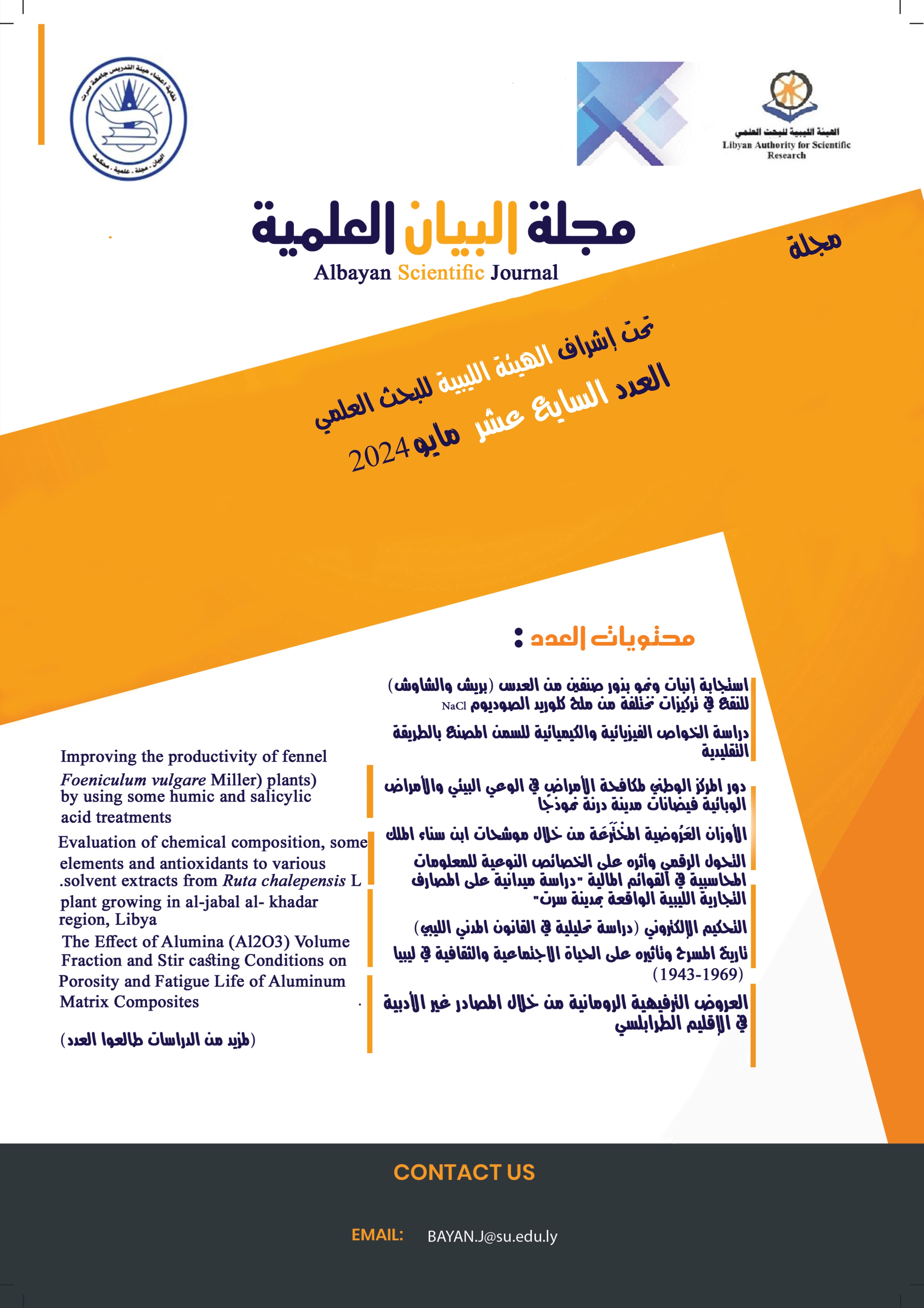Evaluation of chemical composition, some elements and antioxidants to various solvent extracts from Ruta chalepensis L. plant growing in al-jabal al- khadar region, Libya
الكلمات المفتاحية:
نبات الفيجل، نباتات طبيه/ مذيبات قطبيه، الفلافونويدات، مضادات الأكسدة، العناصر المعدنيةالملخص
أجريت هذه الدراسة لتقييم المواد الفعالة و مضادات الأكسدة لنبات الفيجل في نوعين من المذيبات مختلفة القطبية (الايثانول/ الهكسان) وينتمي النبات إلي عائلة Rutaceae وهو من النباتات الطبية ذات الأهمية التجارية ويستخدم لعدة أغراض أهمها مطهر للأمعاء و المعدة و اضطرابات الجهاز التناسلي و البولي و مجهض و مسكن للألآم واضطرابات العضلات ضد الروماتيزم كما أثبتت بعض الدراسات أن له خصائص مضادة للسرطان لاحتوائه على القلويدات والفلافونويدات و الفينولات والأحماض الأمينية و الفورانوكومارين و الصابونيات والتي لها خصائص دوائية مستهدفه بشكل جيد حيث تم جمع النبات في مايو 2023 من مدينة القبه التي تقع شمال شرق منطقة الجبل الأخضر وتم تجفيفها و تحضير المستخلصات للقمم الزهرية والبذور والأوراق والسيقان وأظهرت نتائج الكشف عن المكونات الفعالة بأن تفوق مذيب الهكسان على الإيثانول خاصة في الأوراق بينما سجلت أعلى قيم للعناصر المعدنية (الصوديوم/البوتاسيوم/ النحاس) في الاوراق لمذيب الإيثانول على التوالي (9.14/5.9/42) بينما سجلت أعلى قيمه للحديد في القمم الزهرية والبذور للهكسان حوالي 2.2 مما يدل على تفوق الإيثانول على الهكسان في استخلاص
العناصر المعدنية، بالإضافة إلى تقدير نسبة مضادات الأكسدة لكل الأجزاء المدروسة وأظهرت أعلى قيمه في (الأوراق/ القمم الزهرية/ البذور) 0.3 ميكروجرام/ جرام وأقل قيمه في السيقان 0.09 ميكروجرام /جرام وهذا يدل على أنه كلما ارتفعت نسبة المحتوى الفينولي للنبات زاد نشاط المضاد للأكسدة مما يمنحه إمكانية كبيره لاستخدامه كمضاد طبيعي للأكسدة.
المراجع
• Abdul-Aziz Y. Al-Ghamdi, Abdelfattah A. Fadlelmula, and Mohamed O.M. Abdalla,. (2020): Total Phenolic Content, Antioxidant and Antimicrobial Activity of Ruta chalepensis L. Leaf Extract in Al-Baha Area, Saudi Arabia. Jordan Journal of Biological Sciences. Volume 13, Supplementary Issue, December 2020 ISSN 1995-6673 Pages 675 – 680.
• Aguilar-Santamaria L, Tortoriello J. (1995): Anticonvulsant and sedative effects of crude extracts of Ternstroemia pringlei and Ruta chalepensis. Phytother Res 1995;10:531e3.
• Da Silva, F.G., Da, S., Mendes, F.R., Da, C., Assunção, J.C., Pinheiro Santiago, G.M., Xavier Bezerra, M.A., Barbosa, F.G., Mafezolic, J., Rodrigues Rocha, R., (2014): Seasonal variation, larvicidal and nematicidal activities of the leaf essential oil of Ruta graveolens L. J. Essent. Oil Res. 26 (3), 204–209.
• El-Ghorab AH, Shibamoto T, Ozcan M. (2007): Chemical composition and antioxidant activities of buds and leaves of capers (Capparis ovata Desf. Var. Canesencene) cultivated in Turkey. J Essent Oil Res 2007;19:72e7.
• El-Hefnawy, G. B., El-Borari, M. A., El-Said, A. A. & Gabr, A. A. 1992. Indian J. Fibre Textile Res. 17, 87–91
• Ereifej K, Feng H, Rababah T, Almajwa A, Alu’datt M, Gammoh SI and Oweis LI. (2015): Chemical composition, phenolics, anthocyanins concentration and antioxidant activity of ten wild edible plants. Food Nutr Sci, 6: 581-590.
• Fakhfakh N, Zouari S, Zouari M, Loussayef C, Zouari N. (2012): Chemical composition of volatile compounds and antioxidant activities of essential oil, aqueous and ethanol extracts of wild Tunisian Ruta chalepensis L. (Rutacea). J Med Plants Res 2012;6:593e600.
• Harborne ,J. B., 1973. Phytochemical methods .Chapman and Hall.London .
• Ines Ouerghemmi, Iness Bettaieb Rebey, Fatma Zohra Rahali, Soumaya Bourgou , Luisa Pistelli , Riadh Ksouri, Brahim Marzouk, and Moufida Saidani Tounsi. (2016): Antioxidant and antimicrobial phenolic compounds from extracts of cultivated and wild-grown Tunisian Ruta chalepensis. Journal of Food and Drug Analysis (2016), http://dx.doi.org/10.1016/j.jfda.2016.04.001
• Kacem, M.; Kacem, I.; Simon, G.; Ben Mansour, A.; Chaabouni, S.; Elfeki, A.; Bouaziz, M. (2015): Phytochemicals and biological activities of Ruta chalepensis L. growing in Tunisia. Food Biosci. 2015, 12, 73–83.
• Karmakari I, Dolai N, Saha P, Sarkar N, Bala A, Kanti P. (2011): Scavengingactivity of Curcuma caesia rhizome against reactive oxygen and nitrogen species. Orient Pharmacology Experimental medicine. 2011; 11: 221-228.
• Khalid Al-Ismail, Rawya Al-Atewi, Maher Al-Dabbas and Radwan Ajo. (2022): Antioxidant and A-Amylase Inhibition Activity of Ruta Chalepensis L Extracts. Carpathian Journal of Food Science and Technology, 2022, 14(1), 110-117
• Madhu Babu Kasimala, Merih Tukue, and Robiel Ermias. (2014): Phytochemical Screening and Antibacterial Activity of Two Common Terresterial Medicinal Plants Ruta Chalepensis and Rumex Nervosus. Bali Medical Journal (Bali Med. J.) 2014, Volume 3, Number 3: 116- 121 P-ISSN.2089-1180, E-ISSN.2302-2914
• N. A. Jaradat, A. N. Zaid, A. Abuzant, and R. Shawahna, (2016): “Investigation the efficiency of various methods of volatile oil extraction from Trichodesma africanum and their impact on the antioxidant and antimicrobial activities,” Journal of Intercultural Ethnopharmacology, vol. 5, no. 3, pp. 1–7, 2016.
• Pollio A, De Natale A, Appetiti E, Aliotta G, Touwaide A.(2008): Continuity and change in the Mediterranean medical tradition: Ruta spp. (Rutaceae) in Hippocratic medicine and present practices. J Ethnopharmacol 2008;116:469e82.













